1. Introduction
The photo below illustrates a simple video occultation setup that I been using for the past several years to record both lunar and asteroid occultations plus solar eclipses. With the availability of low cost portable telescopes, CCD video cameras, camcorders and short wave radios, there is no reason not to own and have this simple portable occultation system. (Note: the solar eclipse displayed on the screen in the photo is not the actual field of view using the equipment described below, the eclipse shows a much, much larger field for illustrative purposes only.)
Many occultation observers, including newly recruited observers seem to think that to video record occultations requires a VCR and a small television, in addition to the telescope. This complicates the occultation observations with unnecessary equipment to carry around.
A. The disadvantages to such a system are:
1) VCR - even the smallest VHS format VCRís are not that small. They are cumbersome to carry around and set up and usually require 110 volt AC power source. These units also have strict temperature and humidity limits for good operation.
2) TV monitor - A small television monitor might be a 12" screen or a smaller 5" screen, and again a 110 Volt power source is needed. Even if run on internal batteries, a separate TV monitor is another piece of equipment that needs to be setup and wired into the occultation system.
3) Power source - If your just planning to observe occultations from your back yard, an extension cord is all you need. But if you plan on observing the more spectacular lunar grazing occultations and asteroid occultations you must have a PORTABLE system. To run 110 volts to operate the VCR and TV, a 12 volt to 110 volt power converter would be needed. If you do have a power converter that runs off your car batttery, this is fine, but you must observe right next to your car to power up. Even a portable 12volt source such as a the commercially available auto power boosters are heavy (15 lbs) and bulky to transport around.
B. The Portable Systemís advantages
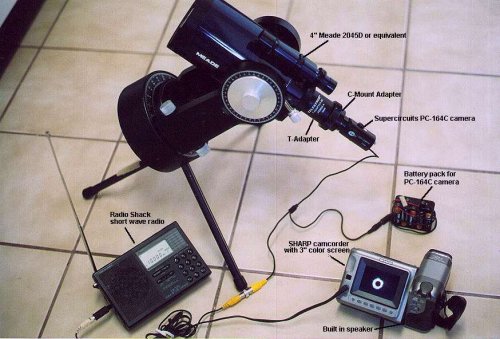 |
This system shown here is completely portable, completely battery powered and all equipment (including the telescope) fits into an average size backpack !! The total weight including the telescope is just 26 lbs. Thus this system can go on airplanes, and the observer can video record from remote sites not accessible by car or boat. |
The major advantages of this system are:
- System records video and WWV time signals directly onto tape in real time
- No microphones or fancy cables needed to record the WWV time signals onto the video tape
- You can see the occultation and hear the WWV time signals in real time exactly as the camcorder records it thanks to a built in speaker on the camcorder
- Since no microphones are used, outside extraneous noise (cars and airplanes passing by) have no effect on the audio portion of the tape
- In a dark sky, this setup can record stars down to magnitude m = +9.5 and with the optional image intensifier stars down to m = +12.8
- Total setup/disassemble time is about 5-10 minutes, plus time needed to find the target star if doing an asteroid occultation
3. System Components
This video setup is simple, and consists of :
- 1) Meade 4" sct or matsutov telescope
- 2) sharp camcorder
- 3) supercircuits pc-164c low light camera
- 4) adapters: t-adapter, c-mount adapter, t-ring
- 5) focal reducer - f6.3
- 6) wwv short wave digital tuning radio
- 7) optional image intensifier
|
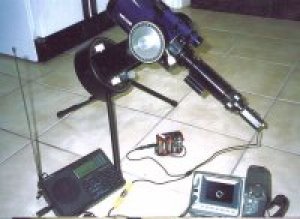 |
These components are described in detail below:
1) Telescope - meade 2045d, sct. this is a f/10, 1000mm focal length 4" aperture telescope. This telescope is no longer made, it was replaced by the Meade ETX series.
Now before you think you have to go out and buy a costly ETX
telescope with the computerized "goto" control, STOP! Although a
computer controlled telescope is nice and convenient, it is not required !
Meade sells a non computer telescope in the 3.5 inch (90mm) size, its
the "etx 90 ra". Its the exact same telescope as the computer driven
ETX-90, but has no computer control. It does have however, an accurate
motor drive. And the cost of this scope is as low as $179.95 from
www.apogeeinc.com. This telescope is sold by most Meade dealers, but
Apogee, Inc. has the lowest price that Iíve seen.
The older Meade 2045D and the new ETX series have 3 screw in tripod
legs allowing latitude adjustments from nearly anywhere in North
America. (And a simple modification can be used if your planning to
observe occultation or eclipse events from near the Earthís equatorial
latitudes using easily found rocks and sturdy tape !!)
A Celestron NexStar 4" or 5" telescope is a good choice also,
except they are moe costly, retailing new for $499 and $1,149 respectively.
EXACT POLAR ALIGNMENT IS NOT NECESSARY !! If your scope is aligned to within 2-3 degrees of the pole, the drive system should keep the target star in the field for 5 minutes easily without any adjustments. Of course the closer you align to the pole, the less adjustments youíll need for your occultation event. These telescopes have manual fine adjustment knobs for declination so youíll always be able to keep the target star in the field of the camera/video.
Power source - 3 "aa" batteries for the Meade ETX 90 RA. Batteries install into scope drive base.
2) Video Recording - I use a non digital Sharp 8mm camcorder with a built in 3" color viewing screen and built in speaker (model vlvl-e650u). this unit is no longer made. it has been replaced by the sharp models vl-ah131u ($279.99 from best buy) and vl-ah151u ($299.99 from best buy. circuit city, and some wal-mart and samís clubs sell these also). both these models are nearly identical in appearance and functions to the older model i use. (the more expensive vl-ah151u has a higher zoom).
These sharp camcorders have the ability to simultaneous record both video and wwv time signals audio directly onto the video tape without any microphones or fancy cables. and furthermore, they have built in speakers so you can hear the wwv time signals and see the occultation exactly as it happens in real time !!
In this system, the sharp camcorder is only used as a vcr and monitor. It is not intended to record occultations directly using its built in lens and zoom.
power source - supplied camcorder battery, it can usually record for 1-1½ hours before recharging.
3) Video Camera - Supercircuits pc-164c black and white ccd camera for $129.95 from www.supercircuits.com. This small camera weighs just 3½ ounces, size is 1.25 x 2.5 inches. Its low light rating of 0.0003 lux is just as sensitive as the more expensive watec cameras. The pc-164c has a slightly smaller size chip than the watec camera but this is a non-issue. The field of view at prime focus on my meade 4" f/10 telescope is 15 x 20 arc minutes, which is perfectly adequate for all types of occultations and recording Bailyís Beads during eclipses.
Power source - 10 "aa" batteries. The cable
from battery pack to PC-164-C is sold by Supercircuits also. The battery
pack is sold by Radio shack and electronic parts stores. Batteries can
provide 3-4 hours of use before replacement. |
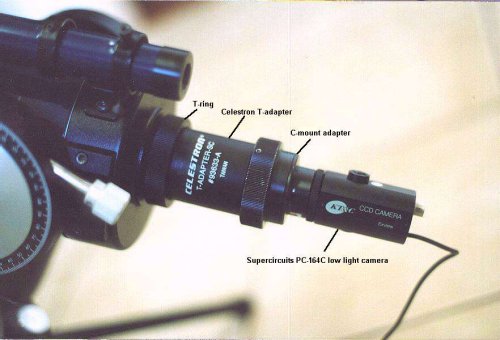 |
4) Video camera adapter - Use T-mount type adapters available from most telescope dealers. Also youíll need a C-Mount adapter. The T-Adapter screws into the threads on the back of the telescope, and the C-Mount adapter threads into the T-adapter. The PC-164C camera threads into the C-mount adapter as shown in photo No. 5. The cost for these adapters varies, they are approx. $25-$35 each.
The Meade ETX series requires a SCT accessory adapter, cost: $30.
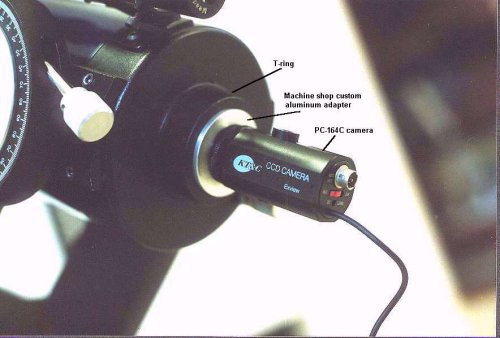 |
Here I had a machine shop make an aluminum
adapter for the PC-164C camera that threads directly into the back of the
telescope. Cost: $50. |
5) f/6.3 focal reducer - This increases the field of view to about 19 x 25
arc minutes, and helps slightly with reaching fainter magnitude limits,
but is not necessary initially. Cost: around $115-130.
6) WWV time source - Radio shack model DX-375 digital tuning radio. You can program in WWV at 2.5, 5, 10, 15 and 20 Mhz so that they can be re-called from memory instantly. Cost: about $100 (less if on sale).This radio has an earphone jack which is the key to direct recording onto
the video tape. The supplied audio/video Input/Output cable for the
Sharp camcorder plus a mono to mono RCA plug
adapter allows the time signal to be recorded directly onto the video tape.
Other features of this radio - It has a strap for hanging, a fold out stand,
a "on/off lock" so you donít accidentally have it on in a suitcase and
wear out the batteries if traveling, and one touch station recall from 9
memories.
Power source - 2 size "c" batteries, they can last for hours of continous
play. |
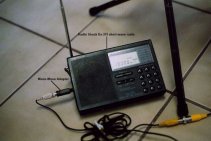 |
7) Optional Image intensifier - The Collins I3 optional image intensifier is placed in between the back of the telescope and the C-Mount adapter. Everything else remains the same. This device comes ready to install. It is sold by Collins Electro Optics (www.ceoptics.com). Its expensive ($2,000, plus $100-$250) extra for a video adapter. This unit was reviewed in Sky and Telescope, February 1999, page 63.
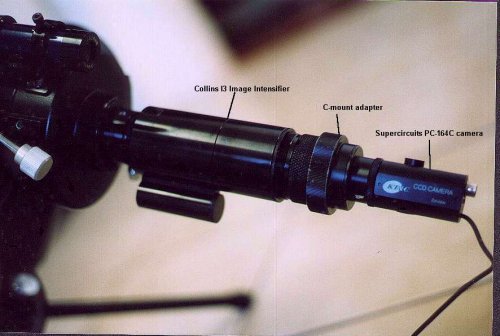 |
The Collins I3 piece will add 3 magnitudes to the limit of your video
system. And it can also be used for visual observing also with the
enclosed 25mm eyepiece, adding 1.5 - 2 magnitudes to your visual
limit. Its also great for star parties in light polluted areas. |
As can be seen by the photos, this simple portable system sets up quickly, and its easy to use. Outside noise interference doesnít matter, since the WWV time signals record directly onto the tape simultaneously with the video from the PC-164C camera.
Richard Nugent
IOTA Executive Secretary
Houston, Texas
Email: rnugent@wt.net





